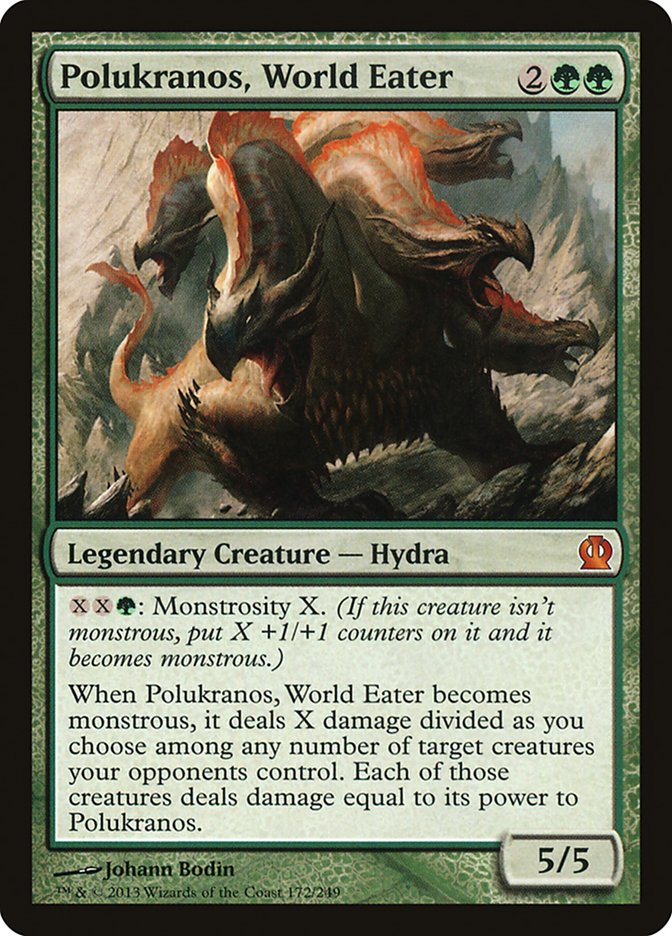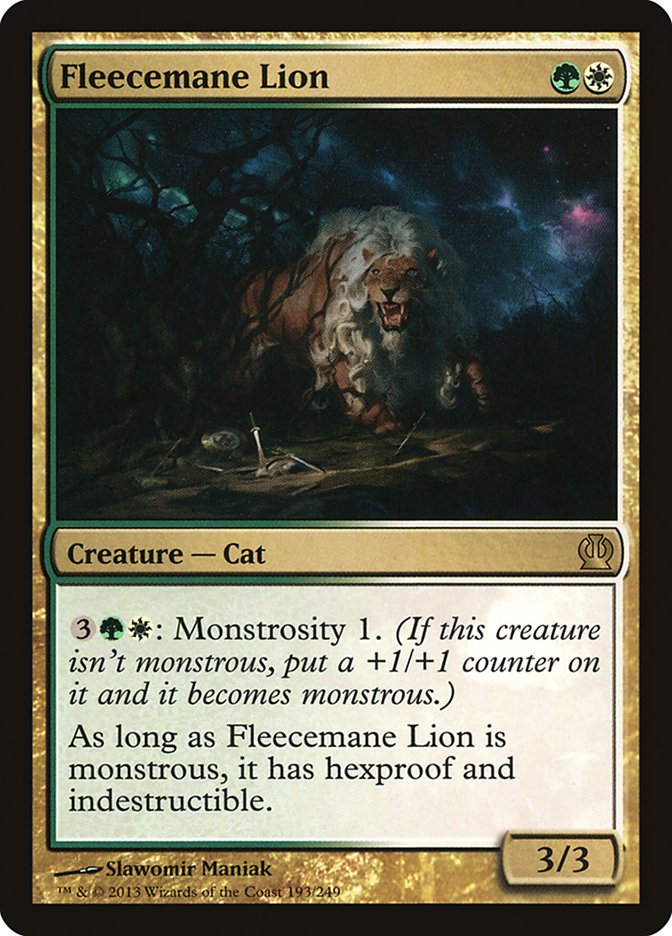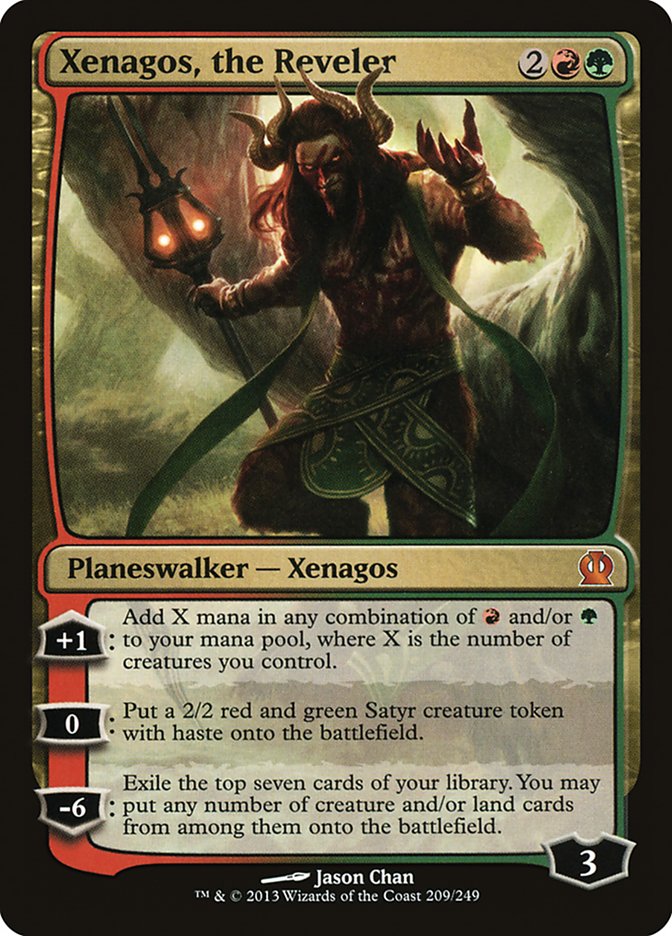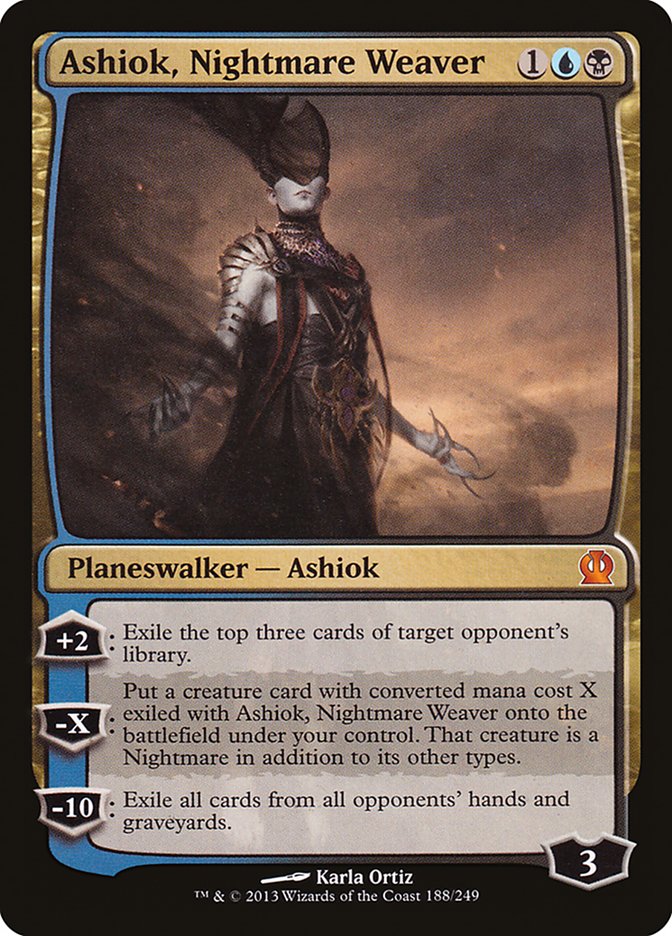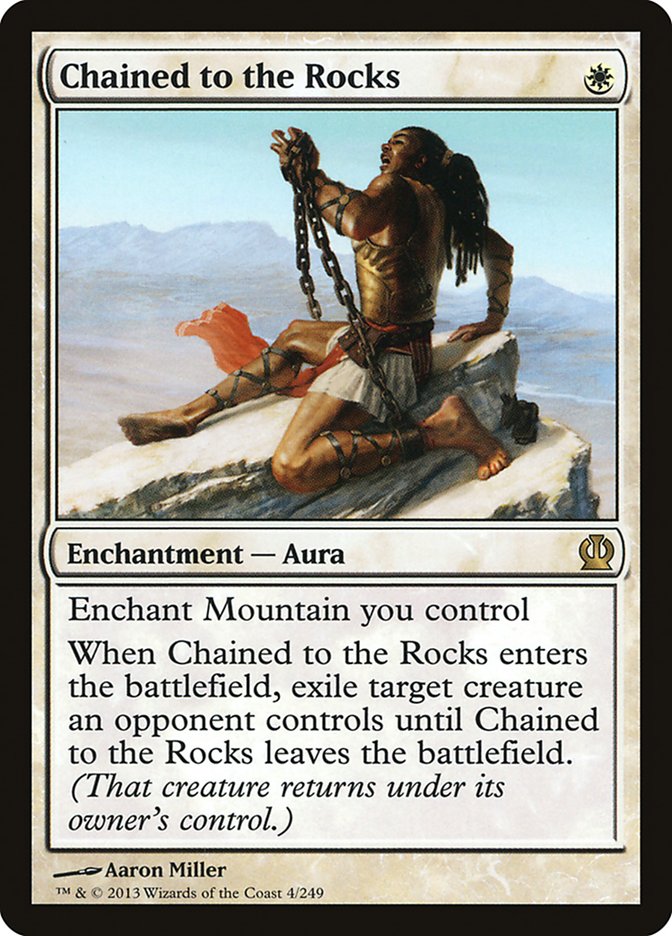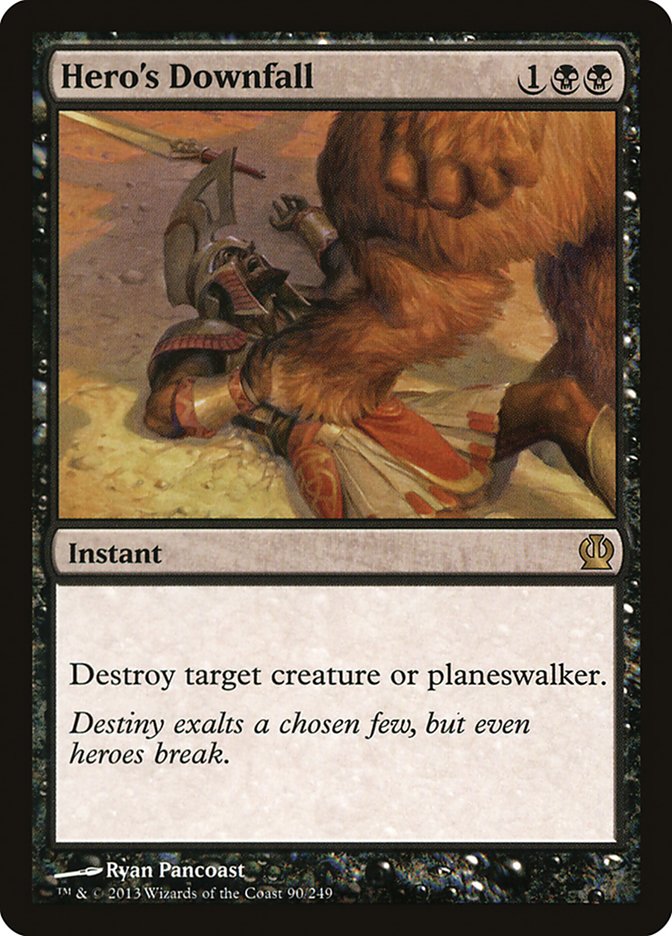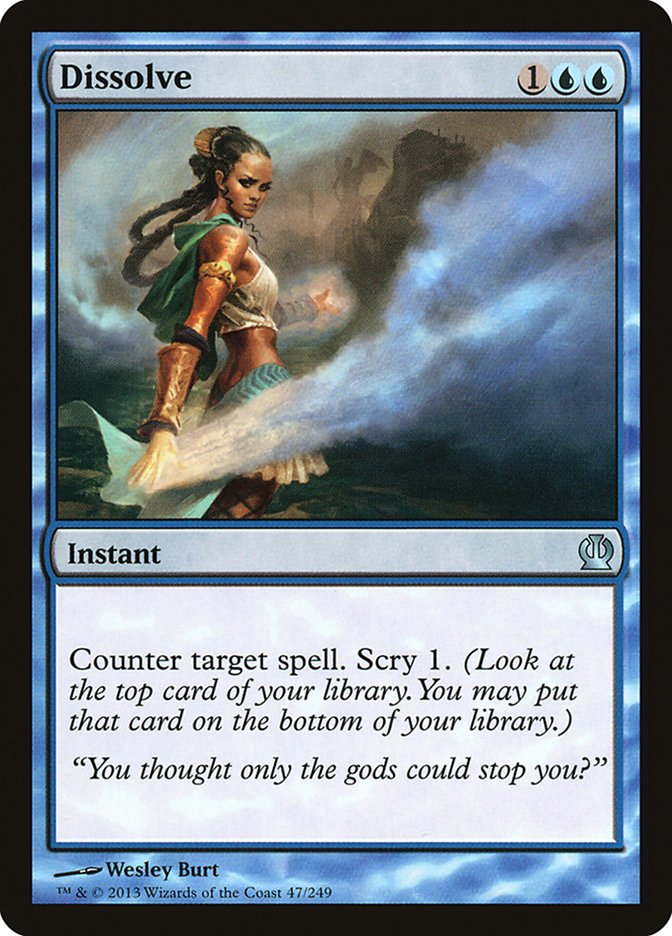Monstrosities
Continuing our exploration of Theros, we now turn to the very cool monstrous mechanic. The base forms of these creatures are lousy but not usually so lousy as to be too punishing if there’s no time to pay the very high monstrosity costs, and there are good rewards for being able to push the big button. Seeding your deck with extra mana sinks and late-game plays is key to making decks and mana draws consistent, which leads to better Magic. These cards are very midrange, as they are "big enough" against small guys and can go over the top of cards that start out more expensive.
Hundred-Handed One (*) doesn’t offer enough value to justify the mana investment. It’s a full mana behind the curve in its small mode, and four mana into six mana is a lot to ask against aggression for a creature without strong protection beyond having five toughness. In addition, I’d like to call this card out for its obvious fence-post error. If a creature with two hands can block one creature, I can see two potential solutions here. Either it’s blocking one and each hand also blocks one once they’re big, in which case it should block 101 creatures, or the first two hands don’t count because everyone is a Two-Handed One, which means it can block 99 creatures. Alternatively, let it block however many it wants, but this is going to drive people like me crazy every time they see Hundred-Handed One.
Sealock Monster (*) is a cool Limited card but not priced for Constructed, as are Stoneshock Giant (*), Nessian Asp (*) and Keepsake Gorgon (*).
Shipbreaker Kraken (*) is trying to be a new Titan and certainly can dominate the battlefield. If you get to eight mana, it’s a 10/10 and locks down their whole team while being a respectable 6/6 in the meantime, but even today that’s overkill. You need your six-drops to impact the board when they come down in a way that both stops the bleeding and puts your opponent behind even if they have a removal spell at the ready. Shipbreaker Kraken does neither of those things.
Hythonia the Cruel (*) also does neither of those things. It looks much better than Shipbreaker Kraken at first glance, but on second glance it is actually much worse because they still have a chance to remove it and black creatures aren’t less vulnerable right now than blue ones.
Ember Swallower (**) is a little more tempting because it has a high payoff. If you get to seven with an Ember Swallower in your deck, chances are at least two of your lands are worthless to you, and there’s a decent chance your opponent is not in that same situation, which means you get a lot more value than just a 7/8. And you always have the choice not to supersize it. The price is you’re giving up most of a mana to get that option and you’ll lose a lot of fights with other four- and five-drops. Is it worth it? My guess is no, it’s not worth it, because it really doesn’t do the low-end job you want it to do. People who are putting this into their decks should not be doing that.
Stormbreath Dragon (***) is a reasonable creature if you don’t make it bigger, which is a huge deal. Instead of needing to commit a ton of mana to have anything good happen, you get good payoff right away and then second payoff later. This is no Thundermaw Hellkite—but protection from white can come in quite handy even with Restoration Angel rotating out, and red decks need something to take over that role. The option to go large is seven mana on a five-drop, so it’s at least somewhat realistic.
Arbor Colossus (***) in practice is quite serviceable in a blocking role right away since 6/6 is safely bigger than what most decks will be throwing at you. Since you’re not attacking, "big enough to block" is as big as you need to be, and then you will usually have the mana on the next turn to at least threaten to get to 9/9 with an upside. It also hits hard enough that you can leave it small when your opponent can credibly threaten to punish you for a large mana investment. The lack of trample is problematic for getting enough out of your investment, but I’m very optimistic about how this card flows. The problem is that telling me to play this over Kalonian Hydra is going to be a very hard sell.
Polukranos, World Eater (****) solves the problem of unaffordable monstrosity costs by allowing it to scale with the mana available, and offers removing a small creature as the side benefit. With solid base numbers on top of that, Polukranos should become a staple creature.
Fleecemane Lion (****) has the best base stats (relative to price) of all the creatures with monstrosity. Triggering doesn’t make the Lion much bigger, but it makes it very difficult to kill, as hexproof and indestructible working together don’t leave that many effective solutions. Even though the cost to do that is more than twice the base cost, at five it’s very affordable, and the threat of doing so can be as strong as its execution.
Polis Crusher (**) is effectively a bad Polukranos, starting out smaller and ending up bigger at exactly zero points on the cost curve, unless enchantments become a huge deal. It only destroys, so it doesn’t take out Gods, which is too bad. I’d have liked to see it as a Titan that did that; flavor would have been very cool. The other advantage it has is trample, which is important for big creatures, but there are too many 4/4 and 5/5 creatures these days to justify losing such an important point of power and toughness.
Nemesis of Mortals (***) should pack quite the punch in Limited as an uncommon and has the potential to be devastating in Constructed as well, likely as a sideboard card. If your creatures are dying left and right, you can get a 5/5 that becomes a 10/10 over two turns for a remarkably cheap price. Two creatures dying is pretty easy, and that makes the base creature on par with Polukranos. If three or more die, you’re getting a great deal on the base creature on its own and likely can afford to upgrade soon if not right away. You’ll have to be all in on creatures over spells to make it work, but that’s an underused tactic in any case.
Then there’s Colossus of Akros (**) for when you need to make sure your finisher will get the job done. This kills in one hit from twenty, and in practice they will almost never survive two attacks without a removal spell that works on it. The problem is that Selesnya Charm and Azorius Charm are real answers you’re likely to face in addition to any other good answers, and if they do answer it, it gets you nothing. There may be places where this is the most reliable answer out there and boarding in one or two will make it very hard to lose long games, but they should be very rare.
The Planeswalkers
There has been a slow but steady and important thematic change in how planeswalkers work. In the beginning, the ultimate ability was supposed to be game winning. It didn’t actually say "win target game," but that was more or less what happened most of the time. With this new batch, the effect can sometimes be very powerful, but we’ve reached the point where the ability can be very non-scary, especially if you have to kill off the planeswalker itself in order to get it. This changes the equation quite a bit, allowing them to be even more powerful in their "normal form" but presenting less of a doomsday device.
Elspeth, Sun’s Champion (***) has an ultimate that provides a strong boost to your creatures and which certainly combines well with the Soldiers you made getting her to seven loyalty, but you’re still talking about a bunch of Soldiers fighting the good fight. If you can hang on to Elspeth, it’s quite powerful, but without her it’s easy to see how you lose. The key to making Elspeth effective is the fork you impose on your opponents. You can block forever if they don’t swarm the board, and the tokens can fight back against small creatures. But if you put out large men, then the -3 ability is devastating. Retribution of the Meek isn’t a universally good card—but when it is good, it is very, very good, and when it isn’t good, the +1 ability isn’t bad. The downside of all this is that six is a lot of mana, but she defends herself so well that I think this could work.
Xenagos, the Reveler (**) is the new Garruk. Presumably he was renamed because Garruk isn’t red and/or we’re all very tired of seeing Garruk after Garruk, but we’re among friends here and this is a Garruk. As a Garruk, he’s pretty easy to compare to similarly priced Garruks like Garruk Wildspeaker and Garruk Relentless, both of which are close parallels, especially Garruk Wildspeaker, who offers a choice of +1 for two mana or -1 for a 3/3. Instead, you have 0 for a 2/2, which is slightly worse than -1 for a 3/3, and +1 for one mana per creature, which is almost certainly worse than two mana most of the time.
If you compare to Garruk Relentless, he was more often than not used as a removal spell with possible residual upside rather than anything else, and there aren’t that many decks that can spend four mana, have a bunch of dudes, and need extra mana that badly. The ultimate here is likely better than Domri Rade’s on average, but there’s a real risk that they can simply Supreme Verdict their way out of it even if you don’t miss, as the lands are often going to be cute but irrelevant as will getting the creatures for free rather than paying for them, which can even be a liability since you have to effectively overextend. I think people are getting way overexcited here.
Ashiok, Nightmare Weaver (***) is a three-mana planeswalker, which is a huge leg up compared to costing four, and has a +2 with which to protect itself. If you leave it alone, it will eventually take out your hand, so the decks incapable of killing Ashiok easily are exactly the ones that have to worry about the ultimate going off, whereas the ones that can prevent that were never under threat from that anyway since you’d rather use the second ability and get one of their creatures.
The combination should cover the majority of opponents, so usually one end of that bargain is relevant to your interests, but there will be cases where it’s granting you creatures you can’t use properly; mono-red, for example, is likely to strand you with a useless ultimate, decking being irrelevant and only Boros Reckoner as a creature worth putting into play, with them knowing when you’re threatening to get your hands on one.
The Staples
I won’t have the time or space to go over everything, so now that I’ve taken care of the set’s core mechanics (scry is awesome, but looking at such cards as a category doesn’t really make sense), I’ll finish up by looking at the staple spell variations. These are the cards that do the things we all love to do on a regular basis, with tweaks to their costs and exact benefits, which form the backbone of any format.
Creature Removal
There isn’t much creature removal in Theros, which many have pointed to as a worrisome sign for Limited play. For Constructed, we have plenty to go around for the time being and get both Hero’s Downfall and Chained to the Rocks for targeted removal and Anger of the Gods as a sweeper.
Limited-quality removal includes Lash of the Whip (*), Sip of Hemlock (* the flavor seems wrong here), Boulderfall (* by the way dude, where’s my scry 1?), Griptide (*), Voyage’s End (*), Sea God’s Revenge (* doesn’t that guy have a name even if it doesn’t get to be Poseidon?), and Time to Feed (*).
Potentially worthwhile reprints include Last Breath (**). Pharika’s Cure (**), Lightning Strike (*** but please stop putting this into every red deck ever, guys), and Magma Jet (***).
Variants that say "scry 1" but are otherwise not new are Vanquish the Foul (*), Lost in a Labyrinth (*cute but trying too hard), Sea God’s Revenge (*), Rage of Purphoros (*), and Spark Jolt (**), which is unplayable now but may earn that rating next year when it isn’t dominated by Electrickery.
Chained to the Rocks (***) is a free gift to Boros, a two-mana removal spell at 50% off. That doesn’t mean you automatically stick four of them into any list that has enough Mountains and white sources because creature removal that doesn’t go to the face is vastly overrated as a maindeck card, but it would be very strange not to have access to the full four copies, perhaps because we’re far enough down that rabbit hole that Peak Eruption becomes a thing. White could also be a somewhat awkward removal color since two strong five-drops have protection from it and this misses Obzedat as well, making it a far more real risk that this will not hit what you want it to hit or even miss outright.
Curse of the Swine (**) should not exist. It is completely out of line for blue to be able to do this on this scale at a price that is borderline reasonable. The good news is that it’s unlikely anyone will want to do so even at a reasonable price, but this card existing bothers me quite a bit.
Hero’s Downfall (****) gives control decks a planeswalker answer they badly need, as well as a way to play creature removal without taking a risk that they’ll miss. It’s such a relief to play creature removal with a second mode rather than creature removal that may or may not work at all. This is a big enough upgrade over Murder to be a serious reward for having double black available early, but that will not be easy to arrange.
Viper’s Kiss (**) is extremely weak sauce, but sometimes it’s the only sauce you can afford. The price is right, and it can sort of get the job done. A corner case to be sure, but it’s not always (quite) as shameful as it looks.
Anger of the Gods (***) lacks the optionality of old versions of this effect and is facing down larger creatures. It is very easy for this not to be an effective sweeper, and even when it is, haste is a real concern. You’ll sideboard it and like doing that, and in the right metagame, you might even maindeck it—not because it’s great but because you don’t have any choice.
Counters
Annul (***) and Gainsay (*** as noted here) are back once again for when that’s what we’re looking for.
Dissolve (****) is top-shelf stuff these days. This feels right and will be our new best friend when playing blue.
Stymied Hopes (*) is too unreliable. Force Spike effects that cost more than one mana don’t work out.
Swan Song (**) is pure genius on multiple levels and will likely do very good work in older formats where winning counter wars can quickly render the extra creature irrelevant and there are key spells to counter on turn 1. Discard is going to be the most important thing to stop on turn 1 or 2 that this is capable of stopping, but even if you’re protecting Supreme Verdict and even if you’re going first, this is still a nerve-racking place to be since it can allow them to avoid committing too much to the board.
Theros is growing on me as a Constructed set as I explore it, but there’s no question that the power level of Standard is going to take a huge leap downward with the rotation. The resulting world feels far closer to Ravnica block than it does to old Standard, but in that world the new cards will make their mark. Even more than before, the cards are encouraging players to be active and do big things, with the ever-present risk the opponent will go larger still taking the place of the risk that your huge armies will be no match for my endlessly recurring Thragtusks, which was shutting down most of my more creative ideas.
As always, the worry is that all of this thinking big will only pave the way for Esper or some other Sphinx’s Revelation based control deck to do what it did in San Diego and the Block format. Whether that happens or not will likely come down to whether the natural builds of the other decks include enough of the cards that fight such strategies, and there’s a lot of early hope that this will turn out to be the case.

